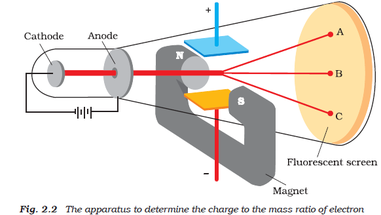
- JJ THOMSON CATHODE RAY EXPERIMENT LED TO THE DISCOVERY OF MANUAL
- JJ THOMSON CATHODE RAY EXPERIMENT LED TO THE DISCOVERY OF TV
Thomson won Nobel Prize in 1906 for discovering the elementary particle electron. Thomson in 1897 when he was studying the properties of cathode ray. The electrons are thus forced to land in the wrong place, causing the distortion of the image and the psychedelic colours.Discovery of Electron Who discovered the electron?Įlectron was discovered by J. The picture on the screen is dependent on the electrons precisely hitting phosphors on the back of the screen, which emit different colours of light when impacted. In the case of the CRT TV, the paths of the electrons are distorted by the magnet being brought near the screen. Making this quantitative point is impossible without control over both particle energy and magnetic field, so this will need to be stated if your demo doesn’t have both of these. The faster the motion of the particle, the larger the circle traced out for a given field or, conversely, the larger the field needed for a given radius of curvature of the beam. This causes a charged particle in a magnetic field to follow a circular path.
JJ THOMSON CATHODE RAY EXPERIMENT LED TO THE DISCOVERY OF TV
Helmholtz coils can then be used to apply a quantifiable magnetic field by passing a known current through them.Ī schematic representation of a CRT TV in cross-section.Ī magnetic field will cause a force to act on the electrons which is perpendicular to both their direction of travel and the magnetic field. Some of these fast-moving electrons crash into the gas inside the tube, causing it to glow, which allows us to see the path of the beam. In the cathode ray tube, electrons are ejected from the cathode and accelerated through a voltage, gaining some 600 km/s for every volt they are accelerated through. Crucially for the Accelerate! recipe, you need a larger magnetic field to bend a faster-moving particle. The key here is that magnetic fields will bend the path of a moving charged particle, and we can make use of this effect to control a beam. Speed of an electron accelerated through 1 V: In this case, turn it off, leave it for a short period, and turn it on again. Sometimes, often after repeated cycling, the TV will fail to degauss. If the distortion and colours remain after taking the magnet away from the TV, turning it off and on again should force the TV to ‘degauss’ which will fix the problem-this is signified by the distinctive clunk which often accompanies a CRT turning on.The image will warp, and sweeping trails of colour will appear. Put the strong magnet near to the TV screen.A relatively still, bright image or video makes the effect we’re about to observe easier to distinguish.


For a TV, many camcorders and digital stills cameras will have an S-video, component or composite connection older camcorders may have these directly, but newer camcorders or digital cameras may have a bespoke cable which plugs into a mini-USB or similar jack on the camera and feeds out to multiple types of connector for insertion into the TV. If it’s a computer screen simply plugging it into a laptop should work.

Having curved the path of the beam, turn up the energy further and show that the curvature decreases with increasing electron energy.If your CRT does have Helmholtz coils, turn up the current in them until the beam bends.You may need to do this quite slowly if the camera is set to a low frame rate to increase its low light sensitivity. If your CRT doesn’t have Helmholtz coils, simply wave the neodymium magnet near the CRT to show the beam bending.Turn up the energy of the electron beam until the gas inside the globe is clearly glowing.Dim the lights and turn on the camera if you’re using one.If you’ve not got a cathode ray tube, an old CRT TV or computer monitor and a strong magnet will provide a more qualitative version of this demo.
JJ THOMSON CATHODE RAY EXPERIMENT LED TO THE DISCOVERY OF MANUAL
The beams of electrons are too dim for anything except a very small audience to see directly, and are something of a challenge for video equipment too! A camera with a night mode, or manual control over gain (or ISO) and shutter speed will probably be necessary. In addition to a cathode ray tube, you’ll probably need a sensitive camera to show your audience the results of this experiment. In the absence of Helmholtz coils, a strong neodymium magnet should suffice to bend the electron beam. The ideal CRT is enclosed by Helmholtz coils to allow a varying magnetic field to be applied. This experiment obviously requires a cathode ray tube filled with gas which glows when electrons hit it.


 0 kommentar(er)
0 kommentar(er)
